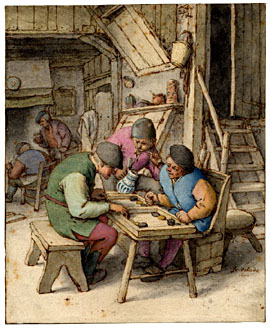|
| Magriel's NYT Columns |
 In backgammon, many games become violent confrontations in which the less fortunate player finds himself facing a closed board with several men on the bar.
In backgammon, many games become violent confrontations in which the less fortunate player finds himself facing a closed board with several men on the bar.
Because the outcome of such confrontations may be decided by a single roll, luck seems to predominate. Skillful play, however, is seldom more important than in these life-or-death situations. The successful player knows not only when to launch an all-out attack, but how to press it to final victory.
In the diagrammed position, Black has attacked White and has so far been successful. With five points closed in his home board, Black needs only to make the 4-point in order to complete the closeout. Conversely, White, with two men on the bar, has only one hope for survival — to establish the 4-point himself. There is no question that, as Black, you must ruthlessly attempt to squelch this hope — the only question is what is the most efficient and reliable way to do so.
|
| Black to play 3-2. |
The proper method in positions such as this (where the opponent has two or more men on the bar), is to wait until he reenters with one man and then hit him — even with a blot if necessary. Accordingly, the correct play in the diagrammed position is 18/13, not slotting, but bringing a new man closer to the 4-point.
|
|
|
In case (a), if White hits you with one 4, you may not be able to hit him back immediately because you are on the bar, and you have lost a builder. If you fail to hit him back, White needs only one more 4 to establish the 4-point.
In case (b), you wait for him to reenter with one man, in the meantime bringing more builders to bear on the 4-point. First, White must roll one 4 to come in. Then, after you hit him, White must immediately roll a second 4 to keep from being closed out. This, in turn, must be followed by still a third 4 to make the point before you can hit him again. Thus, to survive, White needs more 4’s in rapid succession if you don’t slot.
Rollout
 Tom Keith 2013 |
|
Money play White owns 2-cube Black rolls 3-2 2592 games with VR Checker play: 2-ply Cube play: 3-ply Red |
| 3-2: | Game | G | BG | Equity | ||||
| 1 | 23/20, 18/16 |
W L |
.8443 .1557 |
.7149 .0383 |
.0052 .0038 | +1.3134 |

| |
| 3 | 18/13 |
W L |
.8330 .1670 |
.7024 .0363 |
.0051 .0026 | +1.2703 | (0.0431) | (b) |
| 13 | 9/4 |
W L |
.7629 .2371 |
.6128 .0680 |
.0046 .0052 | +0.9819 | (0.3315) | (a) |

|
|

